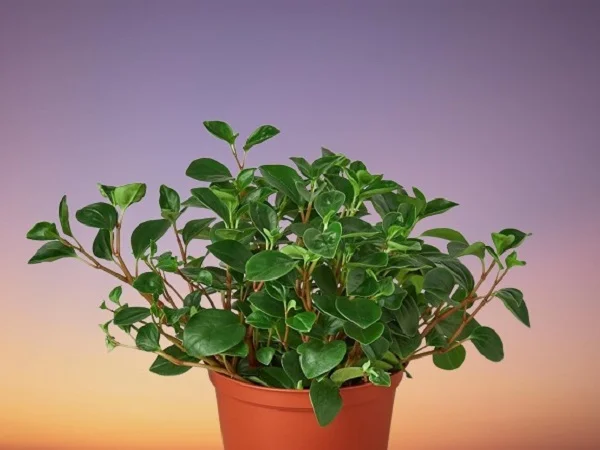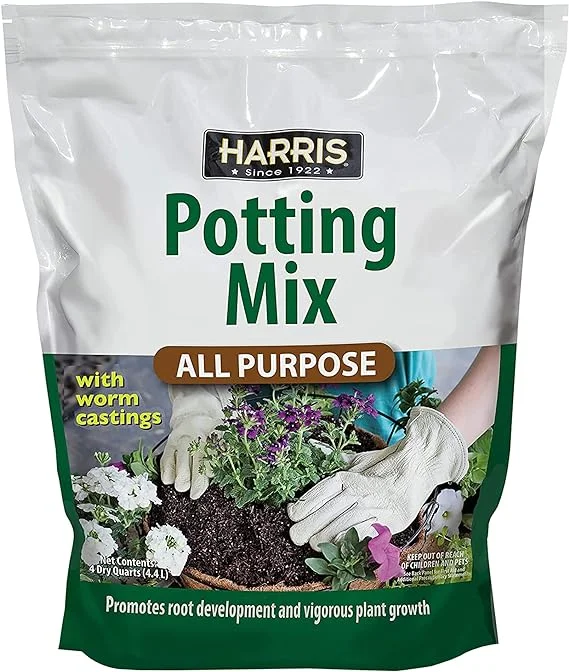How to Grow and Care for Wax Privet Peperomia (Peperomia glabella) Indoors
Some links in this post may be affiliate links
Wax Privet Peperomia (Peperomia glabella) blossoms in medium to bright indirect light, warm and humid conditions and moderately moist, rich, well-drained soils coupled with monthly feeding in the growing season.
Peperomia glabella also called Cypress Peperomia is one of the popular Peperomia varieties with beautiful oval leaves and red stems where the foliage is fleshy and often has variegation.
The oval leaves can be a darker or a lighter green, depending on the amount of light the plant receives. Likewise, the petioles and stems vary from pink to red depending on the amount of light. The flowers are small and insignificant.
Cypress Peperomia is a small, hardy, fast-growing, low-light plant whose stems will spread or trail with ease. It is ideal for a desktop, hanging basket or a pedestal on account of its compact size and trailing stems. It is one of the fast-growing, low-light plants for the home or office space.

Botanical name: Peperomia glabella
Family: Piperaceae
Common names: Wax Privet Peperomia, Cypress Peperomia
Origin
Peperomia glabella is native to the West Indies and a large part of South America, where it can be found growing epiphytically on trees or terrestrially creeping on the ground.
Is Wax Privet Peperomia toxic?
Peperomia glabella like other Peperomia Plants is non-toxic to humans and pets. They are among the pet-safe plants ideal for indoors.
Peperomia glabella Care Indoors
Wax Privet Peperomia (Peperomia glabella) flourishes in medium to bright indirect light away from direct sunlight, average warmth of 15-260C, humidity of 60-70% and moderately moist, fertile, well-drained, all purpose potting soils coupled with monthly feeding during the growing season.
Peperomia glabella requires regular pruning to keep it neat, to encourage a bushy compact growth as well as minimize pest and disease infestations. Repotting is only needed when the plant becomes extremely pot-bound as it grows best when the roots are confined. Keep reading for more on these growing conditions and how to provide them.

Peperomia glabella Variegata
Watering
Water Wax Privet Peperomia liberally during the growing season and allow the top 2-3 inches of soil to dry out between waterings to keep the soil moderately moist.
Significantly reduce watering during the cold season to keep the soil barely moist as growth is minimal at this time.
Make sure that the pot has a drainage hole to prevent the soil from getting soggy as it can result in root-rot. Read more on how to water houseplants the right way
Light Requirements
Wax Privet Peperomia grows best in medium to bright indirect light (dappled light). Keep it away from direct sunshine as it can lead to scorching of the leaves.
Too little light will result in leggy plants and loss of leaf color. If the natural lighting is inadequate, you may grow the plant under grow lights. Check out these full spectrum grow lights on Amazon.
Regularly turn the pot to ascertain that the plant receives light on all sides for uniform growth and also prevent leggy growth.
Temperature and Humidity
Average warmth of 15-260C is ideal for Wax Privet Peperomia. A room temperature that is comfortable for you is ideal for these plants. If the temperatures are outside this range, they impact the growth of the plant negatively. Keep the plant away from cold drafts as they can cause leaf drop.
Peperomia glabella thrives in a humidity of 60-70%. Set pot on a wet pebble tray or use a cool mist humidifier to raise humidity. You may also grow the plant in a closed terrarium as high humidity can be maintained. Wax Privet Peperomia is one of the best plants for a closed terrarium.
Occasionally clean the leaves by damp-wiping with a soft cloth to get rid of dust and also discourage pest and disease infestations. Make sure that there is good air circulation to reduce fungal diseases.
Feeding
Feed Wax Privet Peperomia with a balanced, liquid fertilizer once a month during the growing period. Stop feeding in the cold season as growth is minimal and feeding at this time may lead to fertilizer burn.
Potting Soil
The best potting soil for Wax Privet Peperomia should be rich in organic matter and free-draining to prevent it from getting soggy while providing the required nutrients. All purpose potting mixes are ideal for this plant.
Repotting
Repot Wax Privet Peperomia during the growing season only when the plant has become extremely pot-bound as it grows best when the roots are confined.
Use a pot one size larger than the current one and ensure the pot has a drainage hole to prevent the soil from getting soggy as it can lead to root-rot. Take a look at these pots with drainage holes on Amazon.
Pruning
Pruning Wax Privet Peperomia involves regular removal of dead foliage to maintain the plant neat and tidy as well as minimize pest and disease infestations.
To encourage a bushy, compact growth, regularly pinch off the growing tips. The plant becomes straggly as it ages, therefore, cutback the stems during the growing season to rejuvenate growth.
Propagation
Wax Privet Peperomia (Peperomia glabella) propagation can be done from leaf cuttings or by plant division.
1. How to propagate Wax Privet Peperomia from leaf cuttings in water
Take leaf cuttings from a healthy Wax Privet Peperomia and ensure each leaf cutting has a petiole. The leaf cuttings root easily, therefore there is no need for a rooting hormone.
Allow sometime for the formation of a protective callus tissue over the cuts of the leaf cuttings to prevent rotting.
Place the leaf cuttings in a jar of clean plain water and change the water every 5-7 days.
Place the set up in warm, well-lit place until growth begins at the base of the cuttings leaf petiole. Allow enough time for substantial growth of the roots and new leaves.
Transfer the rooted cuttings to individual pots and place in a warm, well-lit place away from direct sunlight.
Maintain the soil moist until the new Wax Privet Peperomia plants are well established after which you can begin routine care. For a fuller plant, transfer several plants into one pot.
2. How to propagate Wax Privet Peperomia by plant division
Water the Wax Privet Peperomia thoroughly at least one day before to make it easier to divide and also hasten establishment. A well hydrated plant suffers less shock and takes a shorter time to take root.
Take out the Wax Privet Peperomia from its pot and divide it into several sections.
Pot these sections in individual pots and place in a cool shaded place.
Maintain the soil moist until new growth emerges on the sections.
Allow the new Wax Privet Peperomia to be well established before transplanting after which you can begin routine care.
Related: How to Propagate Radiator Plants (4 Easy Methods of Peperomia Propagation)

Peperomia glabella Problems with Solutions
Wax Privet Peperomia (Peperomia glabella) problems include dropping leaves, drooping leaves, brown leaf tips and edges, shrivelled leaves, leggy growth, pests and diseases among others. Keep on reading for more on these problems, their remedies and solutions.
Dropping leaves
There are many and varied causes of dropping leaves in Wax Privet Peperomia. One possible cause of dropping leaves is the temperature is too low. Move the plant to a warmer spot away from cold darfts and maintain an average temperature of 15-260C.
The second possible cause of dropping leaves in Cypress Peperomia is that the plant has been underwatered causing the foliage to wilt. Water the plant liberally during the growing season while allowing the soil to dry out slightly between waterings. Cut down on watering in the cold season but never allow the soil to dry out completely.
Read more on these 12 reasons why Peperomia is dropping leaves with solutions
Drooping leaves
Wax Privet Peperomia may droop its leaves due to cultural faults like underwatering, overwatering, exposure to hot direct sunlight, extreme temperatures, pests and diseases among others.
Read more on these 14 Reasons for Peperomia Drooping Leaves and How to Fix Them.
Pests
Wax Privet Peperomia is prone to pests like spider mites, whiteflies, scale insects and mealy bugs. Isolate the affected plant to prevent spread to other plants and treat it for the pests. Learn how to identify and control houseplants pests.
Wilted and discolored leaves and corky swellings under the leaves
Wilted and discolored leaves and corky swellings under the leaves in Wax Privet Peperomia is due to soggy soil. This is an indication of root-rot. Isolate the affected plant and treat it appropriately for the disease. Learn how to treat root-rot in houseplants.
Diseases
Wax Privet Peperomia is prone to leaf spot disease. Isolate the affected plant and treat it with neem oil as per the manufacturer's recommendations.
Leggy stems (growth)
Leggy stems in Wax Privet Peperomia are due to low light. Cutback the stems to rejuvenate growth and move the plant to a brighter spot where it will receive medium to bright indirect light or instal a grow light if the natural light is not adequate. Check out this guide on understanding light for houseplants.
Brown, shrivelled leaves
The cause of brown and shrivelled leaves in Wax Privet Peperomia is too dry air. The plant prefers a humid environment to thrive. To raise humidity, set the pot on a wet pebble tray or grow the plant in a well-lit bathroom, kitchen, laundry area and other moist areas in the home. Learn more on how to increase humidity for houseplants.
Dry and shrivelled leaves
Dry and shrivelled leaves in Wax Privet Peperomia are due to excess soluble salts in the soil from the water or excess feeding. Flush out the salts from the soil regularly by running a stream of water through the soil until it comes out through the drainage holes and repeat the process several times.
Brown leaf tips and edges
Brown leaf tips and edges in Wax Privet Peperomia are due to sudden drop in temperature from cold drafts. Remove all the damaged leaves and keep the plant away from cold drafts to maintain average warmth of 15-260C.
You liked it? Share on social media.
Related Content
Amazon Associates Disclosure
Homeplantsguide.com is a participant in the Amazon Services LLC Associates Program, an affiliate advertising program designed to provide a means for sites to earn advertising fees by advertising and linking to amazon.com.





